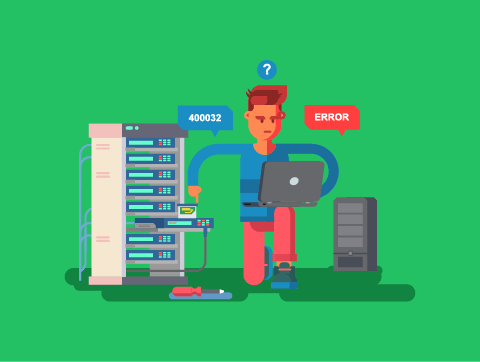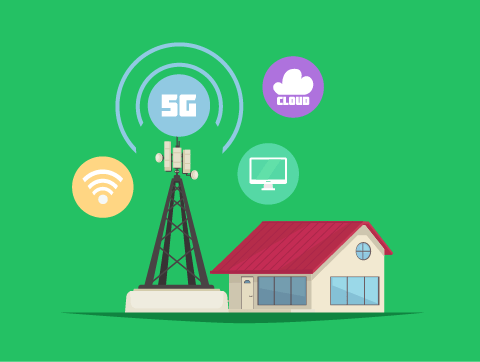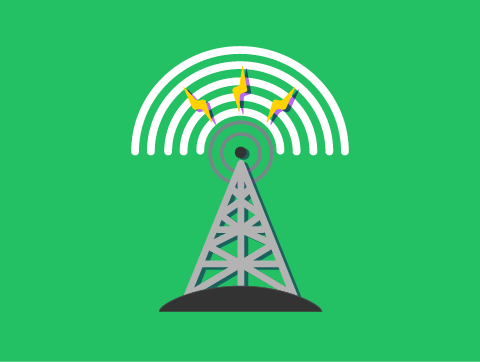Introduction
Communication technologies are systems that allow us to transmit data between devices, such as over a local area network or the internet.
These are essential in the modern world, in our business and personal lives, whether messaging a friend across the street or working with a colleague based in another country.
In this lesson, we’ll learn about:
- Setting up an ad-hoc network
- Security issues with open networks
- Performance issues with ad-hoc networks
- Issues affecting network availability
Setting Up an Ad-Hoc Network
Ad hoc networks, in the context of Wi-Fi and tethering/personal hotspots, refer to a temporary network connection set up for a specific purpose, usually in a limited area.
These networks are “decentralised”.
This means that each device is independent and can function as both a transmitter and a receiver. There is no need for a specific central device like a router or wireless access point.
Two primary ways to set up ad hoc networks are through open Wi-Fi networks and tethering/personal hotspots.

Setting Up an Ad-Hoc Network
Open Wi-Fi
This refers to a Wi-Fi network that does not require a password to join. A user can create an open Wi-Fi network in the Wi-Fi settings on their router, allowing anyone within range to connect.
Tethering/Personal Hotspot
This involves using one device (often a smartphone) to share its internet connection with other devices. You can set up a personal hotspot in the settings menu of your mobile device, which then can be connected to other devices through Wi-Fi, Bluetooth, or USB.

Advantages of Ad-Hoc Networks
Simplified Connection
It is easier to connect devices, so setting up the network is quicker and simpler. This is very important in situations where the users are not very IT literate.
Reduced Costs
It is less expensive because it lacks a central access point, such as a home router. This saves us money on purchasing this device and means we don’t need to carry an additional device around with us.

Disadvantages of Ad-Hoc Networks
Slower Performance
Ad-hoc networks are slower than traditional networks. This is because devices using the ad-hoc networking mode usually only support slower transfer speeds.
Weaker Security
They are usually less secure because wireless connections are commonly used (which are less secure than wired ones), and there is no central device for managing the security of the network.

Setting Up an Ad-Hoc Network

Security Issues with Open Networks
As convenient as ad hoc networks may be, they come with a significant risk: security.
Open networks lack the security mechanisms of password-protected networks, making them susceptible to unauthorised access and misuse.
Specifically, open networks don’t have encryption.
Encryption is where your data is jumbled up to make it unreadable should someone manage to intercept your data.
We’ll learn more about encryption later in the course.
Let’s look at some more specific security issues related to the use of open networks.

Security Issues with Open Networks
Data Interception
On an open network, an attacker can easily intercept the data that you send and receive, including sensitive information like credit card numbers and passwords.
Malware Distribution
Attackers can also use open networks as a platform for distributing malware and infecting connected devices.
Unauthorised Access
With no security barriers, attackers can gain access to your device through the network, manipulating data and settings.

Performance Issues with Ad-Hoc Networks
A major limitation of ad-hoc networks is the performance issues that these networks suffer from.
Maximum Speed
Ad-hoc networks cannot transfer data as fast as networks in infrastructure mode as they have a smaller maximum data transfer speed. The speeds can also be affected by the increased interference.
Maximum Range
Wireless routers have higher-powered antennas and can provide much greater ranges than wireless connections directly between devices. Further, when in ad-hoc mode, operating systems usually hide the signal strength indicator.

Performance Issues with Ad-Hoc Networks
Interference
Ad-hoc networks produce a lot more interference when many devices are connecting, as each has its own connection, with devices often moving around and crossing signals.
This interference can increase the corruption of the data being transferred, which means this data will need to be re-sent. This can reduce range, lead to dropped connections and reduce speed.

Issues Affecting Network Availability
Network connections, most notably your connection to the Internet, are not equal across the entire world.
There are many issues that will affect the availability & performance of both mobile & traditional broadband for end users.
Some of the most common issues include:
- Location of the network
- Developed vs developing countries
- Available infrastructure
- Mobile network coverage
- Blackspots
Let’s look at each of these issues in more detail.

Location of the Network
Cities are likely to have excellent network coverage, as telecom providers will invest far more in these areas due to their higher population levels.
This includes having far more phone masts offering mobile broadband connectivity as well as providing access to superfast broadband, including FTTP (Fibre to the Premises).
This will mean that for those in rural areas you may not have fast fibre-optic broadband in your area and 4G mobile broadband, and even if you do, the speeds will be significantly poorer.
In the case of mobile broadband, it’ll also be more like that you will get dropouts where your internet stops working.

Developed vs Developing Countries
The issues discussed above are even more true of the difference between developed and developing countries.
Developed countries will likely provide excellent network coverage as money will be appropriately put into developing these networks.
A developing country often lacks enough money devoted to its network infrastructure to provide coverage across the country and modern broadband speeds.

Developed vs Developing Countries
The image below shows the difference between 4G availability in Zimbabwe and the UK. Red areas indicate the availability of 4G broadband.

Available Infrastructure
The state of network infrastructure in an area significantly affects network availability.
This includes the physical hardware like cables, towers, satellites, and routers, as well as software systems managing these networks.
Regions with well-developed, modern infrastructure usually offer reliable, high-speed connections.
If the infrastructure is outdated or poorly maintained, it can lead to slow speeds, frequent disruptions, and limited coverage.

Mobile Network Coverage
Mobile network coverage can also affect internet access, especially in areas without wired connections.
Similar to general network infrastructure, mobile coverage is usually better in densely populated urban areas and can be spotty in rural locations.
Generally speaking, 4G broadband covers around 90% of the UK landmass, but this can vary a bit depending on the provider.
Factors such as the distance from the nearest cell tower, the frequency band used by the service provider, and physical obstructions (buildings, trees, etc.) can impact the quality of mobile network coverage.

Blackspots
A blackspot is an area where network service is unavailable. This could be due to the lack of available infrastructure, but it can also be due to physical barriers.
Geographical features like mountains, valleys or hills will disrupt wireless signals as the signals can’t pass through solid stone.
This can be similar in big cities with buildings made of thick concrete, where signals will have an equally tough time getting through.
We could find that our mobile broadband connections drop out while travelling, such as when passing through a tunnel. This would stop anything we’re downloading and cause us to lose something we’ve been working on.

Lesson Summary
The ad-hoc mode of a network allows two devices to directly communicate with each other.
Open networks are unencrypted Wi-Fi networks from which you can connect to the Internet.
Any information sent over an open network is at risk of being intercepted and viewed.
Ad-hoc networks have a limited maximum speed that is low, have a shorter range and are more susceptible to interference.
There are many issues that can affect network availability, including location of the network, developed vs developing countries, available infrastructure, mobile network coverage & blackspots.

